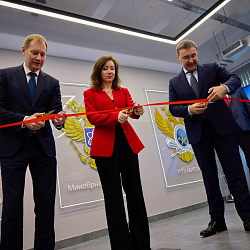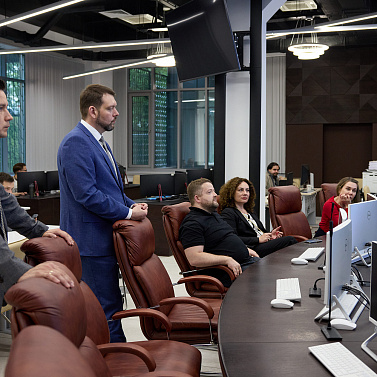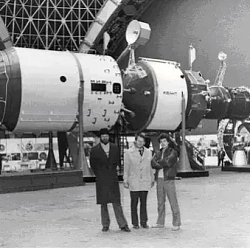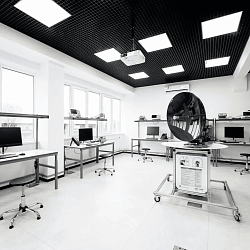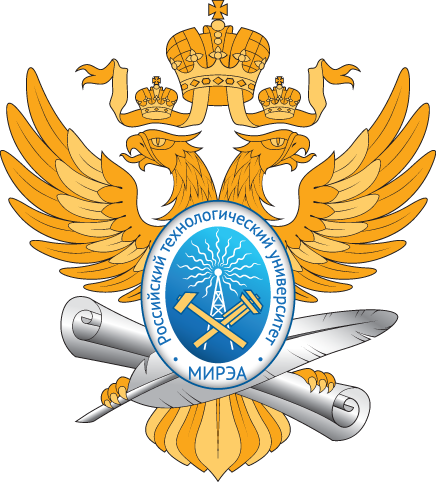RTU MIREA – the milestones of the space journey
MIREA – Russian Technological University has made a significant contribution to the exploration of outer space from the very day of its foundation to the present.
In 2021, the year of the 60th anniversary of the first manned flight into space, the Educational and Scientific Center for Space Monitoring (“KosMoCentre”) was opened at RTU MIREA. The laboratories “Radiolocation and radio navigation”, “Space communication systems”, “Space information systems”, “Monitoring of the environment and outer space” were created. They are equipped with unique laboratory and research equipment from the leading manufacturers, thanks to which students and graduate students have the opportunity to acquire the most up-to-date knowledge and practical skills in the development and use of space electronic equipment.
This is one of the stages of the University's long “space” journey. The formation and development of RTU MIREA has always been closely connected with the progress in the country's space industry.
The University was actively involved in the work relating to Gagarin's flight, the launch of the Energia-Buran space system and the operation of the Mir orbital complex.
The radio transmitter used by Yuri Gagarin in space flight was developed by a prominent specialist in space radio communications, William Ilyich Kaganov. Since 1975, Professor Kaganov has worked at the Department of Radio Transmitters at MIREA.
In 1985, by the decision of the Central Committee of the CPSU and the Government of the USSR on the creation of the long-term orbital station “Mir”, MIREA got an assignment to develop and manufacture the onboard scientific equipment “Istochnik” and “Arfa-E” containing the main elements of radio transmitting devices with an electron beam antenna (EBA). This task was brilliantly fulfilled by the team of university scientists. The scientific equipment worked adequately on the Mir orbital station for 13 years.
From 1986 to 2012, the Department of Radar and Radio Navigation of MIREA was headed by Professor Alexander Pavlovich Reutov, Corresponding Member of the Russian Academy of Sciences, Doctor of Technical Sciences, one of the pioneers in the development of radio-controlled weapons. A.P. Reutov led the program to create an automatic landing system for the Buran unmanned spacecraft. In 1988, with its help, the world's first landing of a reusable orbital spacecraft with full automation of all dynamic operations was implemented.
Professor Grigory Markelovich Chernyavsky, Corresponding member of the Russian Academy of Sciences, one of the founders of the system approach in space engineering, a specialist in the creation of satellite systems for radio communication, radio navigation, and remote sensing of the Earth, devoted to MIREA more than 20 years.
In 1991, Professor Chernyavsky founded and headed the Department of Space Information Technologies. On the basis of the department, a receiving-transmitting center for satellite communications was organized. On the roof of the building at 78 Vernadsky Avenue, parabolic antennas were installed – authentic satellite communication and broadcasting systems that provide reception of signals from artificial Earth satellites that carry out direct television broadcasting.
On January 27, 1994, a space communication session between MIREA and the Mir orbital station was conducted from this sight. Pilot-cosmonaut Anatoly Pavlovich Artsybarsky acted as the communications operator.
Sergei Konstantinovich Krikalev worked as a cosmonaut-engineer at the Center and at the department in the mid-1990s. He was awarded the star of the Hero of the Soviet Union and the Hero of the Russian Federation.
Another recognized “space” achievement of the University is that the planets of the solar system are named after its professors and scholars. In 2001, the International Astronomical Union assigned the minor planet No. 10004 the name of Academician of the Russian Academy of Sciences, Professor, Head of the Department of Control Problems of the Faculty of Cybernetics Igor Mikhailovich Makarov (“Igormakarov”). Another minor planet was later named after another outstanding scientist, Corresponding Member of the Russian Academy of Sciences, Professor, Head of the Department of Theoretical Foundations of Optoelectronics Lev Davidovich Bakhrakh (“Bakhrakh”).
MIREA – Russian Technological University assigned hundreds of highly qualified specialists to the space industry. Our successful graduates work in the field of space information technologies, information processing and transmission systems, satellite communication systems and space navigation.
